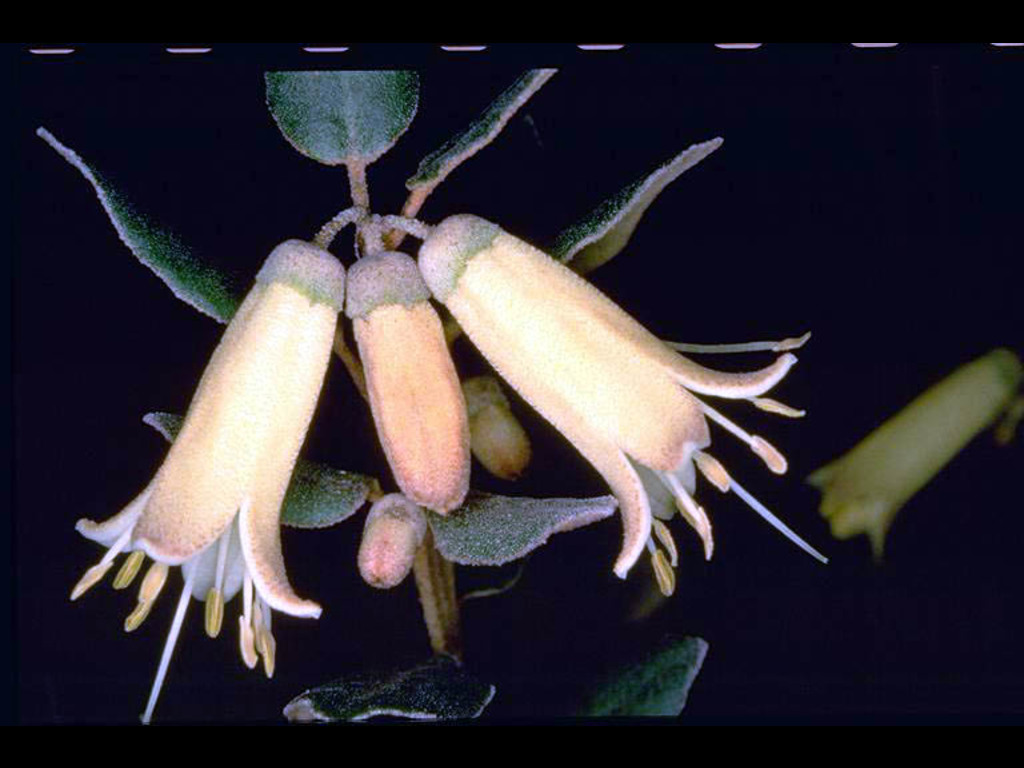Correa backhouseana var. coriacea 'Eucla Gold'
- File Number
- 710
- ACRA Field Book Number
- -
- Registration Date
- 01/09/1999
- Application Received
- 17/06/1999
- Family
- Rutaceae
- Cultivar Name
- Correa backhouseana var. coriacea 'Eucla Gold'
- Origin
- Correa 'Eucla Gold' is a selection from a wild population at Eucla, Western Australia. It is a form of Correa backhouseana var. coriacea. It is believed to be the westernmost population of this species. It was originally brought into cultivation by Alf and Esma Salkin of Mt Waverley, Victoria, in 1988. The applicant was Cherree Densley on behalf of the ASGAP Correa Study Group. Specimen first received by the Authority 17th June 1999.
- Characteristics
- Erect small shrub to c. 1.2 m x 0.8 m with a moderately dense habit. Branchlets highly tomentose with minute rust-coloured stellate hairs becoming green and glabrous with occasional clusters of short stellate hairs on older stems. Simple leaves ovate, 20 mm x 10 mm. Leaf apices acute, leaf bases oblique, venation reticulate, margins entire. Upper surfaces of mature leaves dark green and coriaceous. Upper surfaces of young leaves minutely densely tomentose with white stellate hairs and occasional rust-coloured stellate hairs, becoming more concentrated at margins. Lower surfaces minutely densely tomentose with white stellate hairs becoming rust-coloured on the veins and margins. Flowers axillary or terminal on short branchlets, pedicels 4 mm long, light green minutely densely tomentose with white stellate hairs. Calyx hemispherical, mid-green, coriaceous becoming densely tomentose towards base, 2-3 mm long. Corolla cylindrical, 25 mm x 8 mm with petals barely recurved, creamy yellow with a fine tomentum of rust-coloured stellate hairs becoming concentrated towards tips of petals. Stamens 4+4, inserted at base of disc, filaments broadened towards base, anthers slightly exerted, dark brown, narrow-oblong, apex slightly truncate. Peak flowering is from April to July in most districts. Diagnosis: Distinguished from other C. backhouseana var. coriacea plants which have smaller flowers usually less than 20 mm long and are narrower. Flower colour is also brighter than normal forms, which are pale yellow-green.
- Cultivation
- This cultivar is frost and drought hardy and has a moderately dense growth habit with erect branches. The cylindrical golden flowers which appear in late Autumn are an attractive feature of the plant. It is easy to grow from cuttings and is bird attractive. This form would be suited to a wide range of planting sites and soil types but grows best in a sunny position. It responds favourably to pruning and has been grown by SGAP members for over 8 years.
- Publication
- Hitchcock, M. (2010), Correas: Australian Plants for Waterwise Gardens: 86 (photo)
- Colour Coding
- Corolla tube:1D to 1C, with brown hairs close to 164 series Leaves upper surface:similar to 137A (darker)Leaves lower surface:195B
- Propagation
- Cuttings from semi-firm new growth
- Applicant Name
- Cherree Densley on behalf of the ASGAP Correa Study Group.
- Uses
- As part of a mass planting or mixed in a shrubbery, or as a feature plant. Attracts nectar feeding birds.
- Availability
- Specialist native plant nurseries
- ANBG Accession Numbers
- ACC710, ACRA731, CBG9914012
- NSL ID
- -

